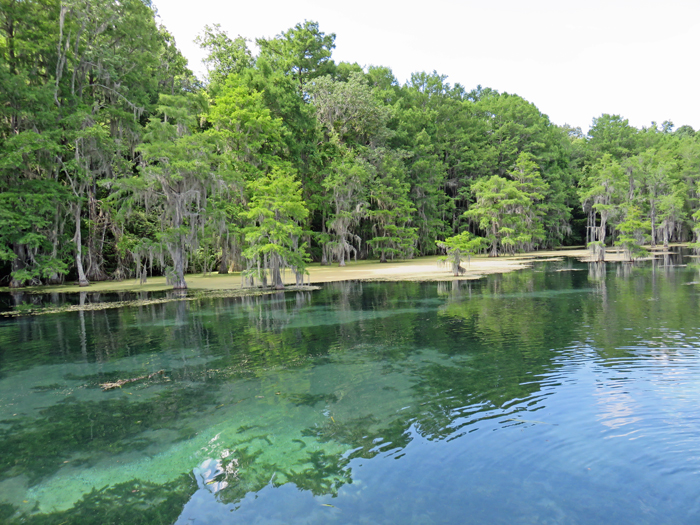
Nitrates are the primary pollutant being addressed by the Jackson Blue Spring/Merritt’s Mill Pond BMAP. This BMAP identifies nitrogen fertilizer used in agriculture as the primary source of nitrates in the Jackson Blue Springs Basin. Photo credit: Doug Mayo
The 2016 Florida Water Bill authorized regulations that will affect everyone in Florida. Farmers and ranchers have implemented Best Management Practices (BMPs) that maintain or improve water quality on their lands for many years on a voluntary basis. But, for those who farm within an area with a Basin Management Action Plan (BMAP), things have changed and BMP implementation is now required. By keeping good records, farmers can show that they are in compliance with regulations, and doing their part to protect Florida’s waters.
What is a BMAP?
A BMAP is a management plan developed for a waterbody (spring, river, lake, or estuary) that does not meet the water quality standards set by the state. Once a waterbody is listed as impaired by one or more pollutants (nutrients, bacteria, or metals such as mercury) the Florida Department of Environmental Protection (FDEP) sets a Total Maximum Daily Load (TMDL) for each pollutant. The TMDL is the maximum amount of a given pollutant allowed in the waterbody while still meeting water quality standards.
The goal of the BMAP is to reduce the pollutant to meet the TMDL. Targets are set at 20 years, and progress towards those targets are assessed every five years. BMAPs are road-maps with a list of projects and management action items to reach the TMDL, and they are developed by FDEP with stakeholder input.
BMAPs in the Panhandle
Here in the Panhandle, we currently have three BMAPS. They are the Bayou Chico BMAP in Escambia County, the Wakulla Springs BMAP in Wakulla County, and the Jackson Blue/Merritt’s Mill Pond BMAP in Jackson County. All three are impaired for different reasons.
- Bayou Chico: This waterbody discharges into Pensacola Bay and is polluted by fecal coliform bacteria. The BMAP addresses ways to reduce coliforms from humans and pets, which includes sewer expansion projects, stormwater runoff management, septic tank inspections, pet waste ordinances and a Clean Marina and Boatyard program.
- Wakulla Springs: Nitrate from human waste is the main pollutant to Wakulla Springs, and Tallahassee’s wastewater treatment facility and the city’s Southeast Sprayfield were identified as the main sources. Both sites were upgraded, greatly reducing nitrate contributions to the spring basin, and now the BMAP is focused on addressing septic systems.
- Jackson Blue/Merritt’s Mill Pond: Nitrate is also the primary pollutant to the Jackson Blue/Merritt’s Mill Pond Basin, but nitrogen fertilizer from agriculture was identified as the main source. This BMAP focuses on farmers implementing Best Management Practices (BMPs), land acquisition by the Northwest Florida Water Management District (NWFWMD), as well as septic systems, recognizing their nitrogen contribution to Merritt’s Mill Pond.
It’s important to remember that a BMAP includes the entire land area that contributes water to a given waterbody. For example, the area that contributes water to Jackson Blue Springs and Merritt’s Mill Pond (either from surface waters or groundwater flow) is about 154 square miles.
Does the new Water Bill change things for agriculture?
The short answer is yes. The 2016 Water Bill modified existing Florida Statutes on protecting water quality and quantity, and added new sections to existing statutes.
One major change affecting agriculture is that management strategies within a BMAP, including BMPs and water quality monitoring, are now enforceable. A producer within a BMAP must show they are either implementing BMPs adopted by the Florida Department of Consumer Services (FDACS), or monitoring water quality as directed by FDEP or a water management district, at their own expense. Simply enrolling land in the FDACS BMP Program is not enough to be compliant.
It is extremely important for producers to maintain accurate records to show that they are implementing BMPs. Local FDACS field staff are there to help producers enroll in BMPs, and the BMP manuals developed by FDACS describe approved management practices and list the required records to keep. The crop and livestock specific manuals are available through the following FDACS Website:
Agricultural Best Management Practices
BMPs and Cost-share Funds
BMPs are a way to maintain or improve water quality, and many help improve soil conditions. Although BMPs are designed to be technically feasible and economically viable, FDACS recognizes that implementing BMPs can be expensive for farmers and ranchers, and some practices may not be financially viable for all producers. It’s important for producers to work with their local FDACS field technician to determine which BMP practices are feasible on their operation.

The use of cover crops is a Best Management Practice (BMP). In this photo the cereal grain triticale is being used as a winter cover crop in Gadsden County ahead of warm season row crops. Photo by Andrea Albertin
Agriculture BMPs are voluntary on land not included in BMAPs, but are required in BMAP areas. By implementing BMPs and maintaining good records, producers can show that they are in compliance with FDEP, and more importantly, are doing their part to meet water quality standards to protect Florida’s waters.
FDACS, the USDA-Natural Resources Conservation Service (NRCS) and the water management districts offer cost-share funds to defer the cost of implementing BMPs. For more information on available cost-shares and funding deadlines, contact your local FDACS field staff, NRCS office and Water Management District. In the Panhandle, contact information can be found at:
-
FDACS BMP Field Staff
-
Northwest Water Management BMP Program for Blue Springs Basin
-
NRCS Field Staff
- Testing Your Irrigation Water: A Key Step for Managing Crops and Equipment - November 21, 2025
- What to Do if Sinkholes Open on Your Property - November 15, 2024
- Crop Farmers Implementing BMPs in the Chipola River Basin - May 24, 2024
